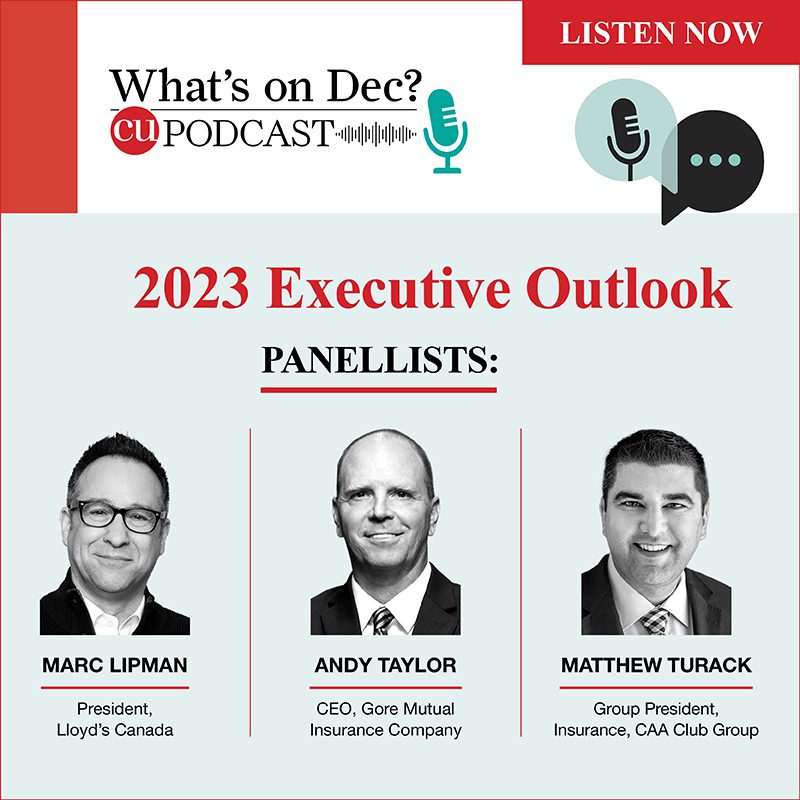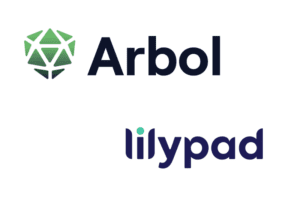What’s on Dec? | Episode 2 | 2023 Executive Outlook

Text transcript
Intro: You’re listening to What’s On Dec?, the Canadian Underwriter podcast, focusing on the hottest topics in the P&C community, featuring insights, analysis, and interviews with subject matter experts throughout the year.
Pete Tessier:
Hey everyone. Welcome to What’s On Dec?, the Canadian Underwriter podcast. It’s brought to you by Taycon Risk. They’re the MGA that specializes in niche markets, hard-to-place or unusually complex commercial risk. They turn hard risk into smart coverage the old fashioned way, they underwrite it. And hey, I’m Pete Tessier with Curt Wyatt from the Insurance Podcast, and we’re back for another episode of What’s On Dec? and we’re going to look into the future, take a look at what’s coming for 2023 and what some industry leaders think is top of mind for them and how they see the marketplace in their own companies going. Right, Curt?
Curt Wyatt:
Absolutely. We’ve dipped into the pool of experts. And it’s really good when you can do this within a space where there’s diversity around thought process. There’s a change in the way these companies are working and the change is needed because a lot of it has happened in the last two years.
Pete Tessier:
Yeah. Look, we’re coming out of unprecedented times. We have so many things going on, economic uncertainty. We don’t know if the global economy is tipping towards a recession. We have a continuing hard market that has no end in sight and all the other variables that come with a very turbulent global picture right now.
Curt Wyatt:
Well, hey, let’s face it, if it isn’t the numbers, it’s about people. I mean, we’re an industry of people. And there’s one thing that’s changed in the last two-and-a-half, three years, and that’s where people work. It’s how they think, what they think about life, their jobs. We get into this. And it’s great to hear the leadership of our industry taking note. They’re going into the back office and they’re talking about what’s important to keeping the industry going in the right direction, Pete.
Pete Tessier:
Yeah. Hey, we’re really excited because we were able to hook up with Andy Taylor, who is the president CEO of Gore Mutual. We also have Matthew Turack, who’s the group president of CAA and its group of companies. And we also have Marc Lipman, who’s the president of Lloyd’s Canada. So we have such a great outlook of companies who are in the insurance marketplace in Canada, but in different ways. And they each bring a unique view of how they’re going to look at the insurance marketplace for 2023 and what they’re going to do with their own companies and guide them into the next year. Let’s get into Marc, Andy and Matthew and let them share their thoughts with us.
Curt Wyatt:
And we’re here with Andy Taylor of Gore Mutual. Looking into 2023 is what the topic is today. And we would love to hear your insight with shifting gears and taking Gore into the future. And what do you guys see as some of the challenges coming up in the near future?
Andy Taylor:
As we look out to next year, a couple things are exciting for us. I think from a financial standpoint, we do see many of those trends continuing, hopefully not to the same extent that we saw in 2022, but I would say the macro environment will remain very challenging in 2023. Issues like inflation at the level that we’re at are not likely to turn as quickly as I think we would like to see. So there’s pressure we’re seeing on costs within the insurance model particularly and in some of our claims lines. You’re also seeing, we’ve felt a lot of the pain through our investment portfolios. We moved quickly to protect capital and de-risk our portfolio, so we’re actually in a very defensive position heading in the next year. We have a lot of cash on hand. The good news is I think we’re also seeing probably the best investment plan we’ve ever built with the higher yields that we’re seeing in our plan for next year.
Pete Tessier:
And now we’re joined by Marc Lipman, who is the president of Lloyd’s Canada. Look, we’re coming out of an unprecedented year in 2022 in the insurance marketplace. We’re looking ahead to 2023. What’s your outlook on the industry as a whole for the coming year now?
Marc Lipman:
I think it’s going to be an ongoing interesting 2023, right? I mean, I think there’s going to be lots of intrigue and lots of factors at play in the market in 2023. I think pricing will remain under pressure, to be honest with you. I think that the hard market, as anyone wants to define it, is probably with us for a better part of 2023. The industry is still processing Hurricane Ian down in Florida, and what that’s going to do to capacity. And very much tied to that is what we’ve been hearing about reinsurance and where the reinsurers are standing for the Jan. 1 renewals. And that has an immediate impact on the direct market as well and what direct writers are going to have to price their products at. Not to mention just strictly speaking, capacity in certain lines like Cat-exposed property and other areas as well. So I think there’s lots that’s going to be going on through 2023.
Pete Tessier:
Hey, we’re joined by Matthew Turack, who is the president, CAA group of companies. Let’s look ahead to 2023. When you think about the market and what we come through in the last two years, what are the things that you’re focused on? What do you see in your crystal ball for the market?
Matthew Turack:
Well, I do think it’s going to be a difficult market for consumers and for insurance companies. We’ve seen a lot of hardening of the market. And whether that is inflation driven or investment market driven and just the return to kind of normalcy, if I put it that way, in terms of people driving and working. So it has changed the market quite a bit. What I look forward to in 2023 is being able to help consumers. I mean, the reality is whether you say we’re in a recession or we’re entering recessionary times, consumers are going to have a lot of pressure on spending and spending power or the ability to have excess cash in their pocket. And everything is costing more, whether it’s groceries or just their ability to afford things, mortgages and everything else.
And consumers need us as insurance companies to show up, to play a part in that and to play a part, and at CAA, we feel that part of the role we can play is really help create stability, but to be there for consumers with great product, with great service, and keep pricing and keep rates as stable as possible for consumers, not be another high price item that they have to worry about, ‘How do I pay for, how do I afford this?’
Pete Tessier:
What do you see for yourself in your position as president of Lloyd’s Canada is top of mind for you when it comes to internal things and how you’re going to position the company and work within your sort of framework?
Marc Lipman:
Yeah, so there’s lots of external issues to respond to. I mean, I think holistically, if you’re asking what’s top of mind, I think what’s top of mind is ensuring that we remain relevant for our policyholders and our trading partners here in Canada. We’ve got to make sure that we continue to offer the right kind of products and services, assist our clients in managing their risk exposures. Our focus always has to be on consistency and ensuring that capacity keeps on flowing to Canada to respond to customers’ needs. We know that in many areas there’s a shortage of capacity already. And as I said earlier, that’s ahead of finding out really what the impacts of reinsurance renewals are going to do on where capacity stood through 2022.
Somewhat unfortunately, but a fair degree of focus also has to go to regulatory compliance and change. 2023 will be the first year that the carriers in Canada start reporting under the new accounting standards under IFRS 17. And then along with that comes a whole host of other regulatory changes that carriers have to respond to at the request of OSFI and some of our provincial regulators as well.
Andy Taylor:
Probably what’s most exciting for us next year, too, is if we think about where we at are in our journey, our transformation of Next Horizon, which is a 10-year vision, actually quite literally today, the day that we’re doing this interview is exciting. We just did the final release of our major technology program. Our commercial lines business went live this morning successfully. And so that marks the end of what we call the ‘be brilliant’ phase of our transformation where we were putting in all new technology, all new operating models, adding unprecedented amount of talent. And we’re really now transitioning into a period where we’re going to be harvesting the benefits of those investments that we’ve made and really trying to drive the performance out of the business. So we call it ‘pivot to performance is actually the narrative around our business plan. So again, next year we’re expecting above industry average growth. We’re still looking at about 10% overall growth in our business. But as you’ve heard, a lot of it’s based on rate coming through the business.
And then we’re also seeing now the rebalancing of our business model. So we put a lot of investment in the transformation. And we reinvested the profits of the business back into the company. We’ve now self-funded that transformation. Now we want to see our ROEs come back up and really start to generate a high performance. So that’s why next year’s an exciting year for us as we’re kind of pivoting from a big T, as we call it, transformation, into more of a continuous improvement in innovation phase for us.
Pete Tessier:
When you think about consumers and what your business model and initiatives are trying to do, what then becomes the most important issue for you as you look ahead to the next year in terms of actions you as a company want to take?
Matthew Turack:
So stability is number one. We need to be there. We are a great company for our employees and very stable and consistent and create lots of development and growth opportunities. We need to be there, again on that stable part, stability for our broker and our broker partners and our business partners to make sure that we are not only the market that they’ve relied on in the past years, but we continue to be the market that they can rely on providing fantastic opportunities and some great offering for their customers and that we reflect their brand in a positive way. And then ultimately the most important part is be there for consumers. Be there from a safety perspective. Make sure that when they need us, we show up. We communicate. If there’s delays, we communicate that we’re going to be there to help them put back their life in those tumultuous claims environments, whether it’s a storm or a different life event that has happened, we want to be there for the customers.
But also that we are going to find solutions for the insureds that come to us that can be there to not only create, again, that consistency on the pricing side, but create a consistency with the products that they have and really show extra value in those products. And we did so through the pandemic. On our home insurance policy, we added travel insurance to that home insurance for every homeowner that not only protects them when they’re travelling, which was a weird thing to talk about during a pandemic, but it also allowed them to have in-province travel medical and virtual travel medical. And so you could connect with the doctor virtually. And those kind of unique values are how can we help people during times of need? And how can we add extra value to create a moment of safety, a moment of protection for them?
Pete Tessier:
Are there any specific action items that Lloyd’s in Canada is going to be looking at and that you want to spearhead? Or do you have a to-do list that is going to sort of carry you through the year?
Marc Lipman:
Listen, I have the to-do list that my bosses give me as well. So I have a long to-do list. And some of the things on that list I mentioned really briefly. I mean, we got to focus at Lloyd’s on making sure that we get ESG right, and particularly the E in ESG. And how we support the transition of all kinds of components of our economy, whether it’s energy or transportation, manufacturing, agriculture to their new business models and help facilitate that.
I would like to focus a fair bit on changing, I guess, the narrative that I hear a lot in Canada, which is the narrative I’m speaking about is the domestics versus Lloyd’s. I don’t think that’s really a helpful narrative. I think at Lloyd’s we’d like to frankly focus and spend some time with domestic carriers on how we can support their growth plans, which might sound a little odd initially. But if you start digging a little bit, you’ll find many of the competitors of Lloyd’s in Canada have their own Lloyd’s platforms, either through related entities or otherwise. And even those that don’t, there’s ways that Lloyd’s can support them in their growth plans and ambitions as well. It’s not, per se, a zero sum game or a finite pie that if I get a larger slice, someone else gets a smaller one. We can grow together. So that’s top priority, or of one of them, for me.
Pete Tessier:
Well, that was pretty interesting, Curt, because there are three different looks at 2023 and where each of those industry and company leaders sees their company fitting in the marketplace. And I think it’s quite fascinating to tell you the honest truth.
Curt Wyatt:
I think what’s exciting here is always something different about getting a person’s voice and capturing the real feeling behind what they’re trying to do.
Pete Tessier:
Yeah. I mean, let’s go back and talk a little bit what Andy said. And I think he’s got a different perspective about things and obviously resiliency is one. They are coming into their next phase naturally of the New Horizon initiative. But I think he was very candid about something a lot of insurance company CEOs don’t talk about, which is where their investments are, and actually looking and saying, “We might need to take on rate to manage what’s going on.” And that’s a very refreshing take in my opinion, because I think it’s really easy for industry leaders to dodge some of those sensitive topics. And Andy addressed it head on.
Curt Wyatt:
As consumers still buying insurance as much as the people who listen to this show either sell it, underwrite it, adjust it, you’re still thinking to yourself, “Hey, am I not seeing interest rates go up?” Pretty simple. I know insurance companies invest in products that typically get a return based on an interest rate versus the effects of equities. And yet at the same time, we know that there’s a tail to this stuff. And Andy talks about that. It isn’t just interest rates go up, insurance companies win. It’s not that simple. And Marc goes into that as well, too.
Pete Tessier: 15:44
Yeah, I think Marc really brought in a little bit about the rate increases there. And I think he’s sort of hinting at that rates are in a range where Lloyd’s can come back in and be a partner in the market. And he was really interesting to say that he wants to almost dispel the idea that it’s Lloyd’s versus the domestics, and that he sees an opportunity for these entities to work together to sort of figure out the marketplace and be a much more functional tandem and bring solutions as opposed to compete for business. Marc wasn’t shy about reinsurance either and some of those issues as well, because that’s a big one, too.
Curt Wyatt:
Absolutely. Yeah, absolutely, Pete. I mean, and then bolt inflation right onto that. And then you flip over to Matt who, hey, born by an association, born by a group of people who’ve banded together to make aspects of being Canadian easier. So CAA, shouldn’t they be aware of what Canadians need? And you hear that. You hear that from Matt when he’s talking about the effects of inflation, the effects that has on the rates that Canadians pay for their auto insurance, for their home insurance, and what that’s going to do to the day-to-day Canadian insurance buyer.
Pete Tessier:
Well, he talks about rate stabilization and why they believe at CAA that that’s important. He also talks a little bit about how they did some product development that was counterintuitive to things that were happening during the pandemic, but how that’s important too to continue to give value and add those products into the mix for customers as well without really initiating a huge rate increase. And I think the one thing that Matthew said that I really appreciate, and I appreciate everything that all of them said, was empathy for the consumer. We have to remember that they don’t want to be in this situation anymore than we do, but they need insurance for all sorts of reasons that are out of their control. And we have to empathize with them and have an understanding of that they’re buying insurance sometimes not because they want to. And everyone knows, I say no one wakes up wanting to buy insurance, but because they need to. And they’re doing it out of a bit of duress. Times are tough. And I really appreciate the idea that Matthew said about empathy and how important that is.
Curt Wyatt:
I think, Pete, it’s a little deeper than empathy too because let’s face it. There’s competition and the competition always isn’t coming from London. It’s not always coming from a domestic insurer. That competition’s coming from the US. It’s coming from overseas. These thought leaders, these individuals that are taking insurance forward into what we see as the future of insurance are having to really look at what’s happening, not on their doorstep, but rather down the street. And as host of the Insurance Podcast, we get to hear some of the really interesting things that are happening around the world. And when we bring it back home to What’s on Dec? and we hear our leadership group thinking similar thoughts, it means that maybe the future for insurance in Canada is pretty bright.
Pete Tessier:
It’s going to take some time, Curt, but I think if I were to tell anyone in the brokering community, in the customer-facing side of the insurance industry, listen with empathy. Be transparent about what’s going on and why things are happening. And don’t be afraid to reach out for unconventional and different solutions that maybe haven’t been available in the past because that’s what I would take away from all this. There is some light, as you said. It’s going to take a little time to get there. And as insurance professionals, I think we’re all going to have to be a little bit patient with a lot of understanding for the people we deal with.
Outro: Thanks for listening to What’s On Dec?, the Canadian Underwriter Podcast.






